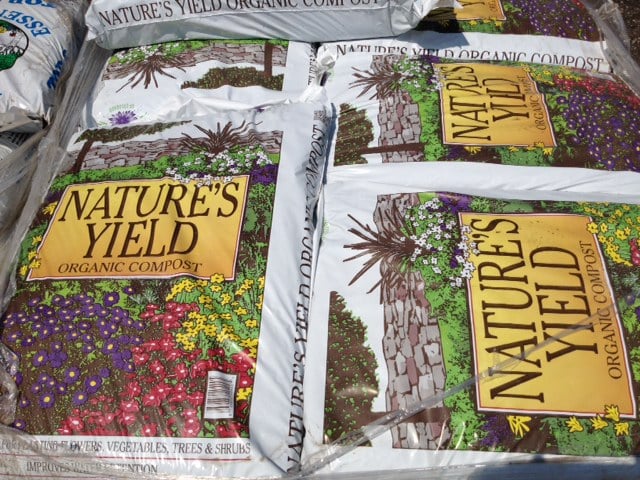A little understanding of our weather conditions and working in our drier, sometimes limiting soil properties will help you improve your garden soil and make smart plant choices this gardening season.
Add Organic Matter
Whether you have overly clayey or sandy soil the best way to improve it is to add organic matter (OM) which eventually becomes humus.
Humus is the result of decomposed organic matter (a word used interchangeably with compost, manure, amendments and decomposing living matter like leaves or grass). The microorganisms break down the organic matter releasing nutrients to the soil to feed the plants.
Humus has the added bonus of binding the three different soil pore sizes, which improves pore space. Clay pores are opened up, resulting in better soil drainage and air to plant roots, while sandy soil pores are reduced, which improves holding moisture and nutrients.
Natures Yield Organic Compost
Bagged soils like, Natures Yield Organic Compost can be added as OM. Or OM may be purchased in larger quantities (by the cubic yard) or added from a homemade compost pile. Typically a layer of 1”-2” is applied to the top of the soil and tilled to a depth of 6”-8” deep.
Natures Yield Outdoor Planters Mix is used for filling in ground level planters like raised beds. Essential Earth Top Soil is used for filling in holes or raising low spots in the lawn or garden.
Caution: Too much of anything, including OM, is not good (over five percent is too much), often interfering with air, water and nutrient penetration to the soil. Too much organic matter can rob plants of nutrients during the decomposition process.
A soil test may be performed for brand new planting beds, where it is important to establish a baseline on salt levels, soil pH, soil texture and other nutrients including nitrogen, phosphorus and potassium. Inexpensive soil test kits from CSU Soil Testing Lab are available for pickup from Creek Side Gardens.
Mulches
Mulches are applied to the surface of the soil to help conserve moisture in the soil and keep the soil temperature cool. Plus, they add landscape appeal. Bark mulches like Western Red Cedar, Redwood Bark Nuggets and Brown Harvest Mulch are applied 2-3” deep. Stone or rock mulches may be used as well.
Soil/ Plant Nutrition – Fertilizers
Plants need additional nutrients in the form of fertilizer to grow to their potential because they are lacking in the native soils.
How is fertilizer applied to the soil?
Liquid- liquid or granular concentrate diluted in water and applied to the soil.
- Easy to apply with watering can or hose end applicator.
- Fast acting- easily available to plants because it is already dissolved in water.
- Will leach more quickly.
Solid – granular incorporated into the soil
- Takes longer to become available.
- Lasts longer.
Which fertilizer should I use?
Don’t get hung up on the numbers. Follow the recommended rate. They all will help!
- Choose your application method – liquid or dry – Jacks for liquid, Espoma or Fertilome for dry
- Choose your preferred source – synthetic or organic.
- Consider the application area – ground/ landscape or containers.
- Consider the crop – flowers, vegetables, shrubs/ trees, lawn.
- Consider the time of the season/stage of the crop – early or late, vegetative or flowers & fruit.
Check with your Green Team staff for a recommendation.
Composting Basics – see more here

